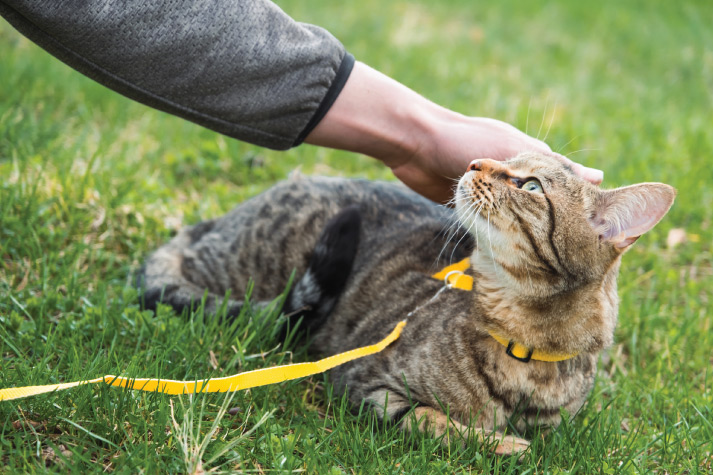A Guide to Cat Harnesses
Cats are generally known as indoor animals, but that doesn’t mean they can never go out. On the contrary, an
occasional visit outdoors and a change of scenery will benefit your cat greatly. Before you can do so, you will
need a couple of things, chief among which is a cat harness. It’ll help keep your feline friend
comfortable, ensure they can run and frolic, and most importantly, make sure they stay safe while enjoying the
great outdoors.
To help you choose the most suitable harness for your cat, we’ve penned this short guide
which outlines the different types of harnesses, their plus points, and where they could do
better.
How to Choose a Cat Harness
There are a few factors to consider before choosing a type of harness for your cat.
- Size of Your Cat: It is important to know the size and measurements of your cat before purchasing a
harness. Different brands will have differing sizes for the same product, so bear that in
mind while you shop for a harness. If you have a kitten, make sure the harness is an adjustable one since
kittens tend to grow quickly. If you have a long-hair breed, make sure to check if any straps or Velcro will
interfere with the fitment and irritate your cat.
- Usage Scenarios: Your cat’s harness should fit your usage. If your trips are
mostly local or to the vet, you could go for an easy-on easy-off harness. If you plan on taking a hike with
your cat, choose a harness that’ll let them move comfortably without compromising on
safety.
- Medical History: Your new harness should not put any unnecessary stress on your cat. Consult your vet
and take your cat’s medical history into account before making a decision. A cat with breathing
conditions, arthritis, or neck/shoulder issues might experience discomfort with certain kinds of harnesses,
so try different kinds of them before buying one for your cat.
Types of Cat Harnesses
- H-Style Harness: As the name states, this style of harness is shaped like the letter ‘H’
and is among the most popular harnesses available on the market. You can fasten such a harness around your
cat’s neck or lead their head through, depending on the exact product you’ve purchased. However,
these harnesses aren’t the most ideal, given the pressure they put on your cat’s neck and the
potential mishaps that sudden movements and jerks could cause.
- Minimal Style Harness: Sometimes called a Y-shape harness, a minimal style harness is
similar to the H-style harness, with the addition of an extra strap across the chest area
to prevent unnecessary pressure. It still strains your cat’s neck and shoulders more than it should,
so keep that in mind. Do remember to measure your cat properly before getting either an H-style or a
minimal-style harness, as the thin straps make it easy for them to escape from.
- Vest Style Harness: Vest-style harnesses resemble a vest and are an ideal harness for your cat, as
the vest-style distributes pressure evenly across your cat’s body instead of pressuring the neck or
shoulders. Vest-style harnesses come in two styles, one where your cat can step into it, and one where you
guide your cat's head through it before doing it up.
- Jacket Style Harness: These harnesses are snug and will cover most of your cat’s body. These
harnesses will ensure your cat cannot slip free, and alternatively, function as protection against the cold.
Go for a breathable mesh harness if you’re in a region with a tropical or temperate climate. The
coverage may lead to your cat fighting against the harness, so make sure to acclimate them to a jacket-style
harness before taking them outdoors in one.
Desensitizing Your Cat
Since your cat hasn't ever worn a harness before, you'll likely have to train them to do so. You can start this by
desensitizing your cat to the harness; leave the harness in the open, close to a food dish or toy so it is
around your cat. Do not force your cat to interact with it, let them be curious and explore on their own. Once
your cat is comfortable being around the harness, you can try slipping it on for a few moments. You might get a
funny reaction like your cat walking weirdly or falling over, but that's normal and to be expected.
Once your cat is comfortable with you slipping the harness on and off, you can let them wear it around the house
for a short period and gradually increase these durations. After that, you can head outside. Make sure to
keep initial outings shorter to observe your cat; if they react negatively, head home and slip the harness
off for another day.
To conclude, there are several options available on the market if you're looking for a cat
harness. Provided you make sure to measure your cat properly, consult your vet, and choose an
appropriate harness, you'll be exploring the great outdoors together in no time.




AUTHOR’S BIO
Shivangi Lawania
Storytelling is my way of bringing ideas to life. I enjoy shaping words that spark curiosity and connection, while keeping a strong focus on branding and communication. For me, great content blends creativity with clarity to leave a lasting impression.